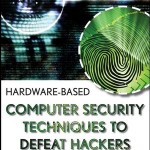
Hardware Based Computer Security Techniques to Defeat Hackers (Wiley) by Roger Dube, maps out solutions for hardware devices used by the Intelligence and Defense communities. Dube begins with an overview of the basic elements of computer security and then covers areas such as cryptography, bootstrap loading, and biometrics.
Chapter Twelve does a good job of covering “tokens,” such as a key card or photo ID. The computer security mantra, “something you have and something you know” is true with securing tokens. Issues such as cost, usability and lockout must be evaluated when considering the use of tokens as part of the user-authentication process.
The book not only discusses the solutions but devotes a chapter at the end to explain how to implement them. A good investment for the CIO and IT Administrator. Available through Amazon for the sale price of $71.96. (retail $89.95)

